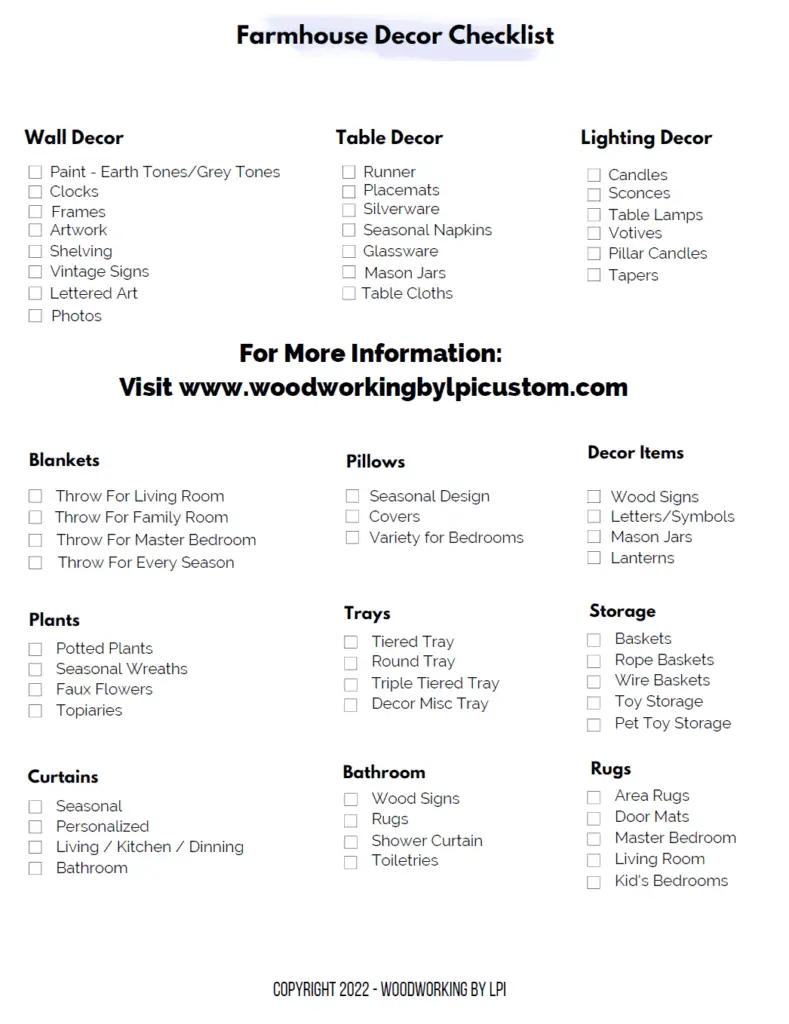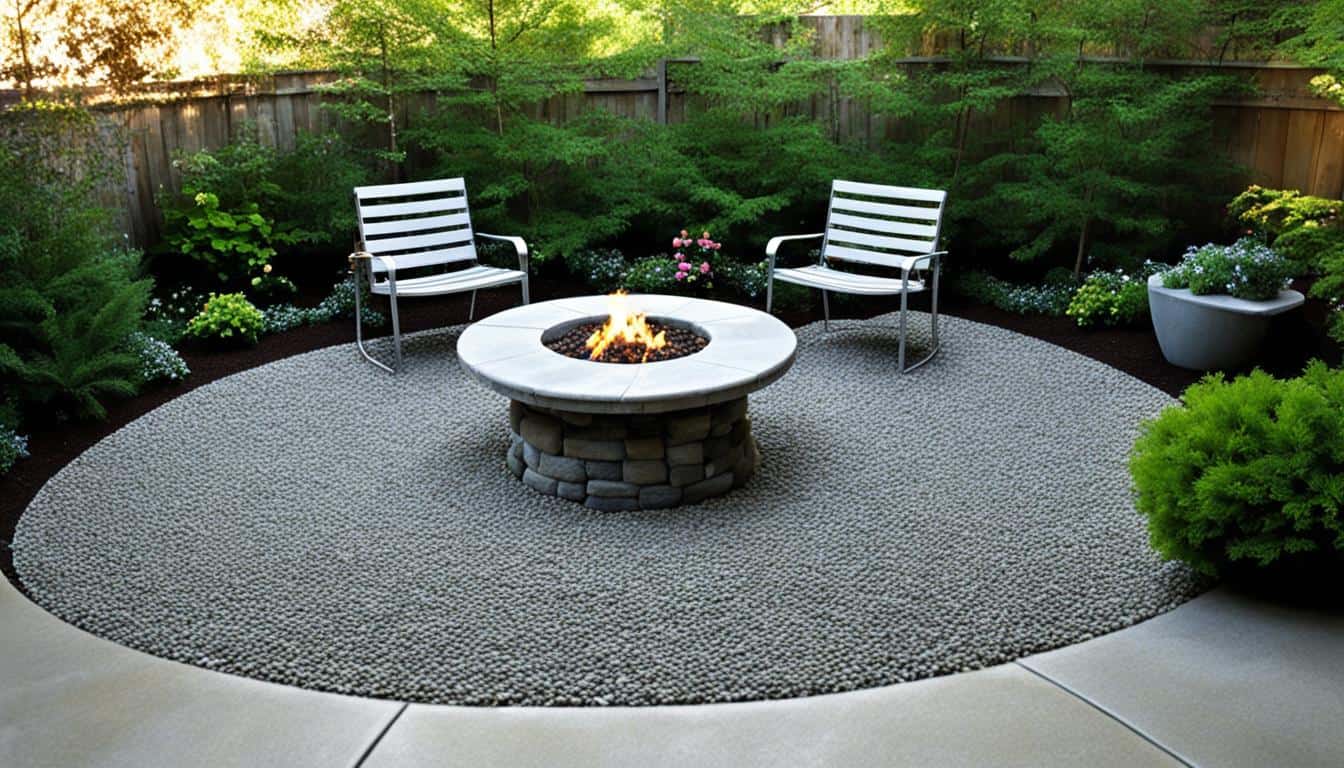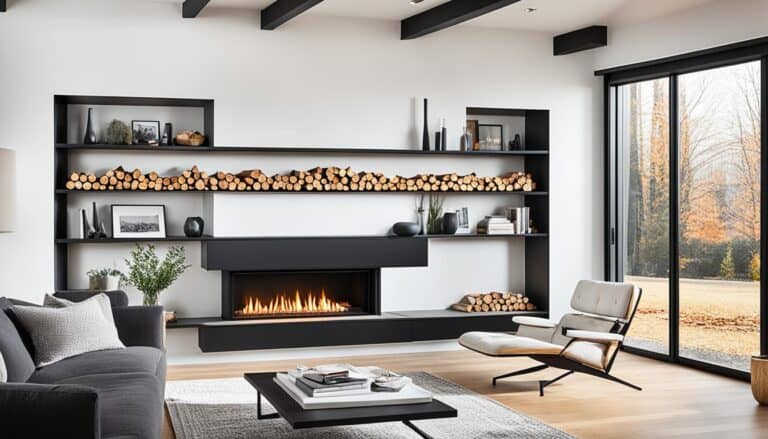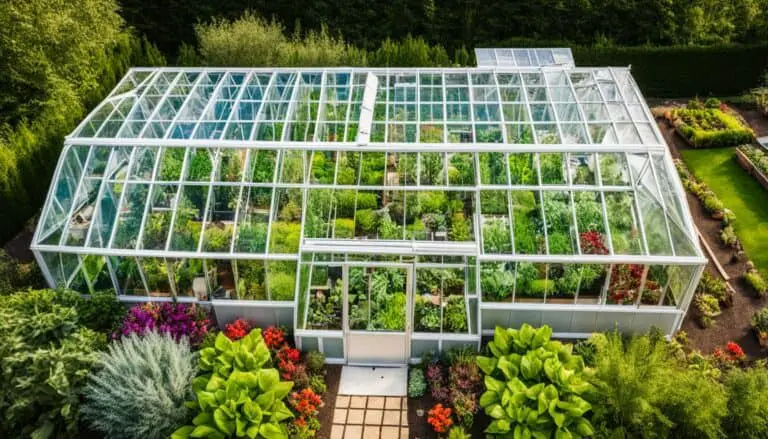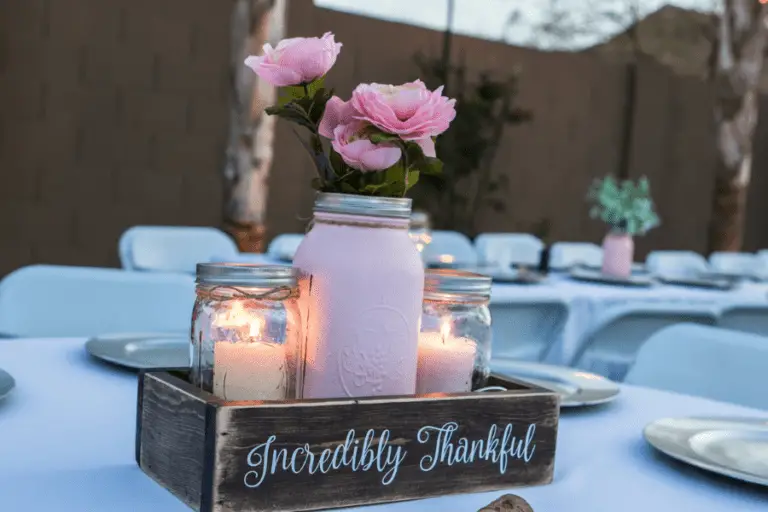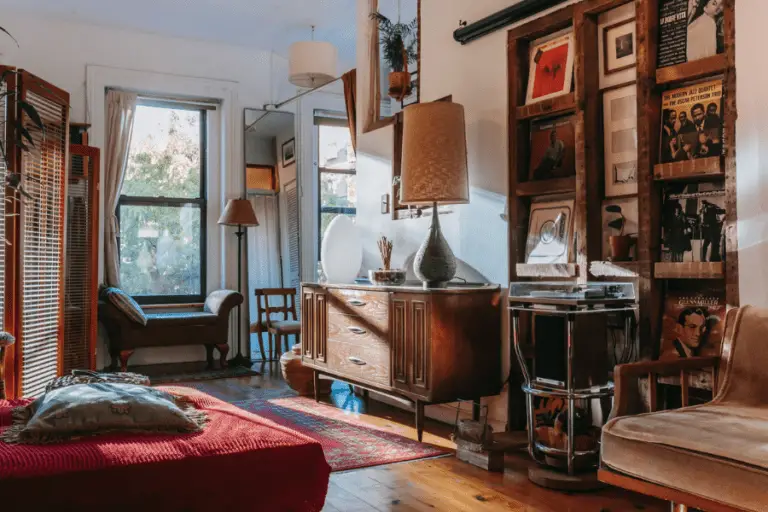Are you considering creating a beautiful outdoor space with a pea gravel patio? Before you dive in, it’s essential to understand the pros and cons of this popular choice. While pea gravel patios offer advantages like affordability and low maintenance, they also come with their fair share of disadvantages. So, are they truly worth it? Let’s explore the benefits and drawbacks of pea gravel patios to help you make an informed decision for your outdoor design.
Key Takeaways:
- Pea gravel patios are cost-effective and easy to install, making them a budget-friendly option for outdoor spaces.
- These patios have a natural aesthetic that can enhance the overall look of your backyard.
- While low maintenance, pea gravel patios may require occasional raking and may not be suitable for heavy foot traffic areas.
- Consider factors like stability, durability, and customization options when comparing pea gravel with other patio materials.
- With proper upkeep, pea gravel patios can provide a charming and functional outdoor area for relaxation and entertainment.
Materials and Tools for DIY Pea Gravel Patio
Before embarking on your DIY pea gravel patio installation, it’s important to gather the necessary materials and tools. Having everything in place will make the process smoother and more efficient. Here are the essential items you will need:
- Sand: Sand is used as a base for the patio to provide stability and drainage.
- Pavers: Pavers are the foundation for the pea gravel patio, giving it structure and strength.
- Pea gravel: Pea gravel is the main material that creates the visually appealing surface of the patio.
- Wheelbarrow: A wheelbarrow is essential for transporting heavy materials like sand and pea gravel.
- Shovel: A shovel will help you dig and level the ground before laying the pavers.
- Gloves: Wearing gloves will protect your hands during the installation process.
- Metal rake: A metal rake is used to level and even out the sand and gravel.
- Metal stakes: Metal stakes are necessary for establishing the desired slope of the patio.
- Landscape string: Landscape string helps you create a straight and level guideline for the patio’s edges.
- Scrap piece of 2 x 4: A scrap piece of 2 x 4 can be used as a leveling tool when working with sand and gravel.
- Level: A level is important for ensuring that the patio is even and free from slopes or bumps.
- Angle grinder: An angle grinder equipped with a concrete blade is useful for cutting pavers to fit the desired shape.
- Concrete blade: A concrete blade is necessary if you need to make precise cuts on the pavers.
With these materials and tools, you’ll be equipped to prepare the ground, lay the pavers, and spread the pea gravel for your beautiful and functional pea gravel patio.
Preparing the Ground for Pea Gravel Patio
Properly prepping the ground is an essential step in creating a stable and long-lasting pea gravel patio. Follow these steps to ensure a solid foundation:
- Start by breaking up the top layer of dirt with a metal rake. This will help loosen any compacted soil and create a better base for your patio.
- Next, use metal stakes and twine to set the desired slope for your patio. This will ensure proper water drainage and prevent any uneven areas.
- Check the level of the ground using a 2 x 4 and a level. Adjust the slope if necessary to ensure it is even across the entire patio area.
- After setting the slope, it’s important to compact the dirt to create a firm base. Use a tamper to press down on the soil, making it more stable.
- To prevent weed growth in the sand layer, consider using landscape fabric. Lay the fabric over the compacted dirt, cutting it to fit the patio area. This will help suppress weed growth and maintain the integrity of your patio.
By taking the time to properly prepare the ground, you’ll ensure a strong and durable base for your pea gravel patio.
Benefits of Preparing the Ground
Properly preparing the ground for your pea gravel patio offers several benefits:
- Improved stability: By compacting the dirt, you create a solid base that can better support the weight of the pea gravel and withstand heavy foot traffic.
- Longevity: A well-prepared ground helps prevent shifting and sinking of the patio, ensuring its longevity and reducing the need for frequent repairs.
- Weed control: Using landscape fabric acts as a barrier, preventing weeds from growing through the pea gravel and keeping your patio looking neat and tidy.
| Advantages of Prepping the Ground | Disadvantages of Skipping Ground Preparation |
|---|---|
| Enhanced stability | Risk of shifting and sinking |
| Extended lifespan | Patio may become uneven over time |
| Weed control | Increased weed growth |
Adding Sand Layer for Pea Gravel Patio
Once you have prepared the ground for your pea gravel patio, the next step is to add a layer of sand. While there are sands specifically designed for pavers available for purchase, they can be quite costly. An alternative option is to order a large bag of sand, which is more budget-friendly.
To add the sand layer, start by spreading it evenly across the prepared ground. Use a 2 x 4 and a level to ensure the sand is distributed uniformly. This will create a smooth and level surface for your pea gravel patio.
Make sure to maintain the slope and level that you established during the ground preparation process. This will help with proper drainage and prevent any potential water pooling issues on your patio. Double-check the slope and level before moving on to the next step.
Now that you have added the sand layer, the foundation for your pea gravel patio is nearly complete. The next sections will guide you through the remaining steps, including laying the pavers and spreading the pea gravel.
Why Use Sand for Your Pea Gravel Patio?
The sand layer serves multiple purposes in the construction of a pea gravel patio. Firstly, it helps create a level and stable base for the pavers, ensuring that they remain in place and do not shift over time. The sand also aids in drainage, allowing water to flow through the gaps between the pavers and into the underlying soil.
Additionally, the sand layer acts as a barrier between the dirt or clay beneath and the pea gravel on top. This prevents the gravel from sinking into the ground, maintaining the integrity and appearance of your patio.
Laying the Pavers for Pea Gravel Patio
Now that you have prepared the ground and added the sand layer, it’s time to lay the pavers for your pea gravel patio. This is an essential step in creating a stable and visually appealing patio. When it comes to laying the pavers, you have the flexibility to choose the starting point based on your preferences and needs.
Consider factors such as accessibility and stability when selecting the starting point for your pea gravel patio. You want to ensure that the patio is easy to access and provides a strong foundation. It’s recommended to start from a corner or edge, working your way across the patio area.
One important aspect to keep in mind is achieving a clean and precise fit for your patio. For the edges of the pavers, you may need to cut them to ensure a seamless appearance. To cut the pavers, you can use an angle grinder equipped with a concrete blade. This tool will help you achieve accurate cuts and maintain the desired shape for your patio.
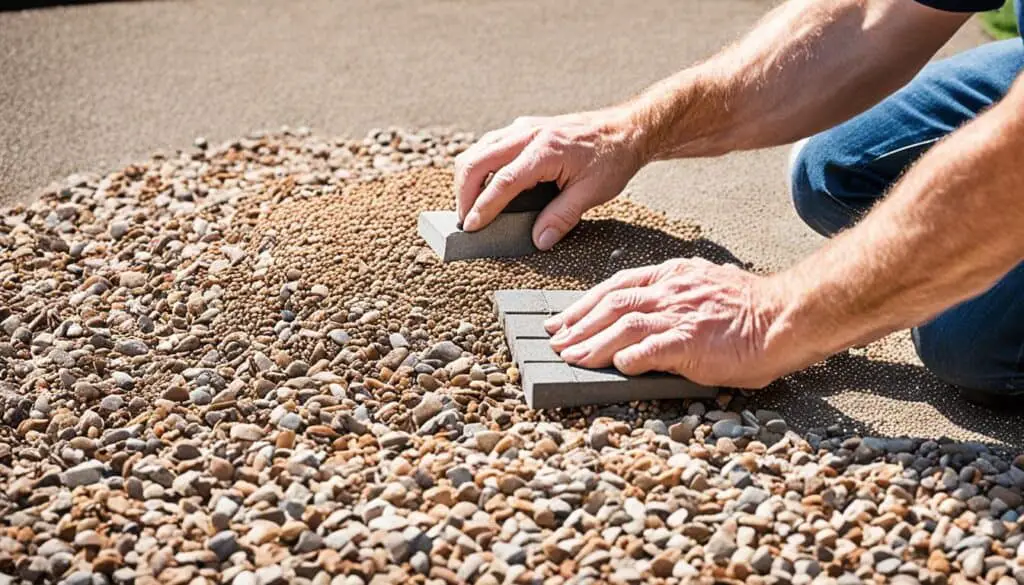
Once you have laid the pavers and made any necessary cuts for the edges, take a step back and assess the overall alignment and placement of the pavers. Ensure that they are level and properly spaced. This attention to detail will contribute to the overall aesthetic and functionality of your pea gravel patio.
Tools for Laying Pavers
| Tools | Usage |
|---|---|
| Angle grinder | To cut pavers for edges |
| Concrete blade | Attach to the angle grinder for precise cuts |
| Tape measure | To measure the size and space of the patio |
| Chalk or pencil | To mark the layout of the patio |
| Rubber mallet | To gently tap the pavers into place |
By carefully laying the pavers for your pea gravel patio, you can achieve a polished and attractive outdoor space. The proper alignment and precise cuts will contribute to the overall durability and visual appeal of your patio.
Spreading Pea Gravel for Pea Gravel Patio
The final step in creating your pea gravel patio is spreading the pea gravel between the pavers. This step not only enhances the look of your patio but also adds stability to the overall structure. Properly spreading and packing the pea gravel will help keep the pavers in place and prevent shifting.
Before you begin, it’s important to determine the amount of pea gravel you’ll need for your patio. The quantity will depend on the size of your patio and the desired depth of the pea gravel layer. As a general rule of thumb, for a 12×12 area, you’ll typically require approximately 12 bags of pea gravel. However, it’s always a good idea to measure the dimensions of your patio and consult with a local supplier to ensure accurate calculations.
Once you have the required amount of pea gravel, you can start the spreading process. Begin by distributing the pea gravel evenly across the patio, ensuring that it fills the gaps between the pavers. Use a shovel or a rake to spread the gravel, working from one end to the other. Take your time to achieve a consistent layer, ensuring that the pea gravel is spread uniformly.
After you have spread the pea gravel, the next crucial step is to pack it tightly. This will help create a solid and stable surface for your patio. Use a tamper or the back of a shovel to firmly pack the pea gravel between the pavers. Apply pressure in a repetitive motion, ensuring that the gravel settles into place and forms a strong foundation.
To complete the process, rinse off the pea gravel to remove any dirt or debris that may have accumulated during installation. This will give your pea gravel patio a clean and polished look. Use a garden hose with a gentle spray to wash away any impurities, taking care not to displace the packed gravel.
By following these steps to spread and pack the pea gravel, you’ll create a beautiful and durable patio that will stand the test of time. Enjoy your newly transformed outdoor space!
| Materials | Tools |
|---|---|
| Pea Gravel | Shovel |
| Rake | |
| Tamper | |
| Garden Hose |
Pros of Pea Gravel Patio
A pea gravel patio offers numerous advantages that make it a popular choice for outdoor spaces. Whether you’re looking for a cost-effective solution, an easy DIY project, or a natural aesthetic, a pea gravel patio has got you covered.
Affordability
Compared to other patio materials like concrete or stone, pea gravel is incredibly cost-effective. It can help you achieve your desired outdoor space without breaking the bank. Plus, the materials required for a pea gravel patio are relatively inexpensive.
Easy Installation
One of the standout benefits of a pea gravel patio is its simplicity when it comes to installation. With some basic tools and materials, you can easily turn it into a satisfying DIY project. No advanced skills or professional assistance needed!
Natural Aesthetic
A pea gravel patio can create a charming, natural aesthetic in your outdoor space. The small, rounded stones bring a rustic and relaxing vibe to any patio design. You can even play around with different color options for a customized look.
Permeability
One of the unique advantages of pea gravel is its permeability. Unlike solid materials like concrete, which can cause water runoff, pea gravel allows water to drain through easily. This helps to prevent pooling and improve overall drainage in your outdoor area.
Low Maintenance
Another great perk of a pea gravel patio is its low maintenance requirements. Unlike some other patio materials that may require regular cleaning or refinishing, pea gravel simply needs occasional raking to keep it looking fresh. It can also be easily replenished or rearranged if needed, giving you more flexibility in maintaining your outdoor space.
| Advantages of Pea Gravel Patio |
|---|
| Affordability |
| Easy Installation |
| Natural Aesthetic |
| Permeability |
| Low Maintenance |
Cons of Pea Gravel Patio
While pea gravel patios have many benefits, it’s important to consider their drawbacks before making a decision. Here are some disadvantages of pea gravel patios:
- Potential Shifting and Scattering: One drawback of pea gravel patios is that the gravel can shift and scatter under heavy foot traffic. This may lead to uneven surfaces and require occasional raking and maintenance to keep the patio looking its best.
- Not Suitable for Extreme Weather: Pea gravel may not be the best choice for areas with extreme weather conditions. Harsh winters or heavy rainfall can cause the gravel to wash away or freeze, making the patio less stable and potentially hazardous.
- Limited Wheelchair Accessibility: Pea gravel can pose challenges for wheelchair accessibility. The uneven surface may make it difficult for wheelchairs to roll smoothly and can cause discomfort or difficulty for individuals with mobility impairments.
Despite these disadvantages, many homeowners still find pea gravel patios to be a practical and visually appealing option for their outdoor spaces. It’s important to weigh these cons against the advantages and consider your specific needs and preferences before deciding on a pea gravel patio.
Pros and Cons of Pea Gravel Patio
| Pros | Cons |
|---|---|
| Affordable compared to other patio materials | Potential shifting and scattering under heavy foot traffic |
| Easy installation as a DIY project | Not suitable for extreme weather conditions |
| Create a natural aesthetic | Limited wheelchair accessibility |
| Permeable, allowing water to drain through easily | |
| Low maintenance and easy to replenish or rearrange |
Comparison with Other Patio Materials
When it comes to choosing the right material for your patio, it’s essential to consider the pros and cons of different options. Let’s compare a pea gravel patio with other commonly used patio materials, such as concrete and stone.
Pea Gravel Patio
A pea gravel patio offers several advantages. Firstly, it is highly affordable compared to materials like concrete or stone. Pea gravel is readily available and can be purchased in bulk at a relatively low cost. This makes it an excellent choice for budget-conscious homeowners.
Secondly, a pea gravel patio is easy to install, especially as a DIY project. With basic tools and some preparation, you can create a charming outdoor space in no time. The simplicity of installing a pea gravel patio makes it an appealing option for those who enjoy DIY projects or want to avoid hiring professional contractors.
Additionally, pea gravel patios have a natural aesthetic appeal. The small, rounded stones create a soft and inviting ambiance, blending well with various landscape designs. The unique texture and color variations of pea gravel make it a versatile choice for outdoor spaces.
However, there are a few downsides to consider. One disadvantage of a pea gravel patio is that the stones can shift or scatter under heavy foot traffic. This may require occasional raking and maintenance to keep the surface even and stable. Furthermore, pea gravel may not be the best option for areas with extreme weather conditions or when wheelchair accessibility is a concern.
Concrete Patio
Concrete is a popular choice for patios due to its durability and versatility. One of the major advantages of a concrete patio is its long-term stability. Once properly installed, concrete provides a solid and sturdy surface that can withstand heavy use and various weather conditions.
Another benefit of concrete is its ability to be customized in terms of color, texture, and design. Concrete patio surfaces can be stamped, stained, or textured to resemble other materials such as brick, slate, or flagstone. This allows homeowners to achieve a specific aesthetic without the higher cost associated with using natural materials.
However, there are a couple of drawbacks to consider. First, concrete patios can be expensive, especially if you opt for decorative finishes or extensive customization. The cost of materials, labor, and additional treatments can quickly add up, making it a pricier option compared to some others.
Secondly, concrete installation usually requires professional expertise and specialized equipment. Pouring and curing concrete correctly is crucial to avoid cracks, uneven surfaces, or other structural issues. This means you may need to rely on professional contractors, adding to the overall cost of the project.
Stone Patio
Stone patios offer a timeless and elegant look, adding a touch of natural beauty to outdoor spaces. One of the main advantages of a stone patio is its durability. Stone is a long-lasting material that can withstand harsh weather conditions and heavy foot traffic without significant wear and tear.
Additionally, stone patios provide a sense of sophistication and can enhance the overall value of your property. With various types of stone available, such as flagstone, limestone, or slate, homeowners can choose a specific color and texture that complements their desired aesthetic.
However, there are a few considerations with stone patios. Firstly, stone can be a more expensive option compared to pea gravel or concrete, especially if you opt for higher-end materials or intricate designs. The cost of sourcing and installing stone can be significant, making it less budget-friendly for some homeowners.
Furthermore, stone patio installation is typically more labor-intensive and time-consuming. The process involves careful planning, leveling the ground, and precisely positioning each stone to create a level and stable surface. This may require professional installation or extensive DIY efforts.
| Material | Pros | Cons |
|---|---|---|
| Pea Gravel | – Affordable – Easy installation – Natural aesthetic | – Shifting under heavy foot traffic – Not suitable for extreme weather conditions or wheelchair accessibility |
| Concrete | – Long-term stability – Customizable design options | – Higher cost – Professional expertise required for installation |
| Stone | – Durability – Sophisticated appearance | – Higher cost – Labor-intensive installation |
Consider your budget, desired aesthetic, and maintenance requirements when comparing different patio materials. Each option has its unique benefits and drawbacks. By evaluating these factors, you will be able to make an informed decision that suits your specific needs and preferences.
Design Tips for Pea Gravel Patio
To enhance the look of your pea gravel patio, consider incorporating design elements and features that will elevate its overall aesthetic appeal. By combining pea gravel with complementary materials and thoughtful design choices, you can create a stunning outdoor space that reflects your personal style and enhances your enjoyment of the patio.
Decorative Borders and Edging
Add decorative borders or edging to your pea gravel patio to create a defined and visually pleasing boundary. Choose materials that complement the color and texture of the pea gravel, such as natural stone, brick, or pavers. This will not only enhance the overall look of the patio but also provide a practical function by preventing the gravel from spilling onto surrounding areas.
Pathways
Create pathways within your pea gravel patio design to guide foot traffic and add visual interest. You can use stepping stones, pavers, or flagstones to create a designated path that leads to different areas of your outdoor space. Consider curving the pathways to create a more organic and inviting flow.
Focal Points and Seating Areas
Integrate focal points and seating areas into your pea gravel patio to create inviting spaces for relaxation and entertainment. This can be achieved by incorporating features such as a fire pit, water feature, built-in seating, or outdoor furniture. Place these elements strategically to create a visually appealing arrangement and ensure optimal functionality.
Combine Materials
Experiment with combining pea gravel with other materials to add texture and visual contrast. For example, you can incorporate flagstone or larger stones as stepping stones or create a designated seating area with a concrete or stone patio. This combination of materials can create an eye-catching look that is both visually appealing and functional.
Outdoor Furniture and Accessories
Complete the design of your pea gravel patio by adding outdoor furniture and accessories. Choose pieces that are weather-resistant, durable, and comfortable. Consider incorporating elements such as patio umbrellas, cushions, outdoor rugs, and decorative lighting to create a cozy and inviting atmosphere.
Remember to personalize the design of your pea gravel patio to suit your preferences and lifestyle. Whether you prefer a minimalist, modern look or a more eclectic and bohemian style, the design possibilities are endless. Get creative, experiment with different elements, and create a space that not only enhances the look of your patio but also reflects your unique personality and taste.
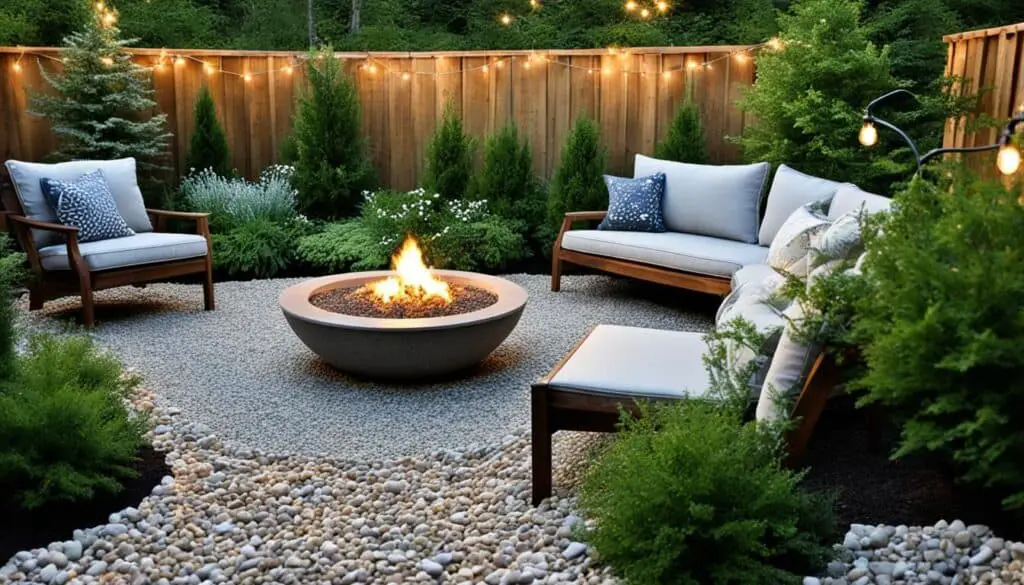
| Design Tip | Description |
|---|---|
| Decorative Borders and Edging | Add borders or edging to define and contain your pea gravel patio. |
| Pathways | Create pathways with stepping stones or pavers to guide foot traffic. |
| Focal Points and Seating Areas | Include features like fire pits or water features to create visual interest and seating areas for relaxation. |
| Combine Materials | Experiment with combining pea gravel with other materials to add texture and contrast. |
| Outdoor Furniture and Accessories | Complete the design with weather-resistant furniture, cushions, rugs, and lighting. |
Maintenance Tips for Pea Gravel Patio
Proper maintenance is essential for keeping your pea gravel patio in excellent condition and maximizing its lifespan. By following these maintenance tips, you can ensure that your patio remains clean, level, and visually appealing.
Rake Regularly for Even Distribution
Regularly rake your pea gravel patio to redistribute the gravel and prevent uneven areas. Use a garden rake or a specialized gravel rake to gently level the surface. This practice also helps to remove any compacted or displaced gravel, keeping your patio looking fresh and uniform.
Clear Away Debris and Leaves
Remove any debris or fallen leaves that may accumulate on the surface of your pea gravel patio. These can undermine the overall aesthetics and encourage the growth of weeds or moss. Using a leaf blower or a broom, sweep away the debris to maintain a clean and tidy appearance.
Consider a Stabilizing Agent
If you notice that the pea gravel tends to shift or scatter due to foot traffic or other factors, consider using a stabilizing agent. These products, such as gravel grid systems or binding agents, help to minimize movement and keep the gravel in place. Follow the manufacturer’s instructions for application and reapplication, if necessary.
Address Drainage Issues
Ensure proper drainage in your pea gravel patio to prevent water buildup, which can lead to erosion or pooling. Assess the slope and grade of the patio to ensure water flows away from your house or other structures. If necessary, make adjustments to the underlying soil or install drainage systems to redirect excess water.
By implementing these maintenance tips, you can keep your pea gravel patio in top condition and enjoy its beauty and functionality for years to come.
Cost and Budget Considerations for Pea Gravel Patio
When it comes to creating an outdoor space, budget is an important factor to consider. The good news is that pea gravel patios are a budget-friendly option, allowing you to enhance your outdoor area without breaking the bank. The cost of materials for a pea gravel patio, such as gravel and pavers, is relatively low compared to other patio materials.
The total cost of your pea gravel patio will depend on various factors, including the size of the patio and any additional features or materials you choose to incorporate. To ensure you stay within your desired spending range, it’s essential to set a budget beforehand.
Consider the following cost elements for your pea gravel patio:
- Gravel: The cost of pea gravel can vary depending on the quantity you need and the supplier you choose. On average, expect to pay around $4 to $8 per bag of pea gravel. For larger projects, bulk purchasing may offer cost savings.
- Pavers: If you decide to include pavers in your patio design, the cost will depend on the type and quality of the pavers you select. Concrete pavers typically range from $1 to $10 per square foot, with higher-end options costing more.
- Additional Materials: Depending on your design preferences, you may need additional materials such as sand, landscape fabric, and edging. These materials can add to the overall cost of your pea gravel patio.
Example Budget
Here’s an example budget breakdown for a 12×12 pea gravel patio:
| Item | Estimated Cost |
|---|---|
| Pea Gravel (12 bags) | $60 – $96 |
| Concrete Pavers | $144 – $1,440 |
| Sand and Additional Materials | $50 – $150 |
| Total | $254 – $1,686 |
Please note that prices can vary based on location and supplier. It’s always a good idea to shop around and compare prices from different sources to find the best deals.
By carefully considering your budget and estimating the costs involved, you can create a stunning and affordable pea gravel patio that enhances your outdoor living space without breaking the bank.
Conclusion
In conclusion, a pea gravel patio offers numerous advantages as well as a few disadvantages. One of the main benefits is that it is an affordable option for creating an outdoor space, especially when compared to other patio materials like concrete or stone. Another advantage is the ease of installation, making it a popular choice for DIY enthusiasts.
Additionally, pea gravel patios require low maintenance, which is ideal for individuals who prefer minimal upkeep. However, it is important to consider the potential for the gravel to shift and scatter under heavy foot traffic, which may require occasional raking and maintenance.
To determine whether a pea gravel patio is the right choice for your outdoor space, carefully weigh the pros and cons discussed throughout this article. Consider your specific needs, preferences, and budget. By making an informed decision, you can create a beautiful and functional patio that suits your lifestyle and enhances your outdoor living experience.
FAQ
What are the advantages of a pea gravel patio?
Pea gravel patios offer affordability, easy installation, a natural aesthetic, and permeability for water drainage.
What are the disadvantages of a pea gravel patio?
Some drawbacks of a pea gravel patio include potential shifting under heavy foot traffic, maintenance requirements, and suitability for extreme weather or wheelchair accessibility.
What materials and tools are needed for a DIY pea gravel patio?
Essential materials for a DIY pea gravel patio include sand, pavers, pea gravel, landscape fabric. Tools needed include a wheelbarrow, shovel, metal rake, metal stakes, landscape string, level, angle grinder, and concrete blade.
How do I prepare the ground for a pea gravel patio?
To prepare the ground for a pea gravel patio, break up the top layer of dirt, set the desired slope using metal stakes and twine, and compact the dirt. Consider using landscape fabric to prevent weed growth.
How do I add a sand layer for a pea gravel patio?
Spread sand evenly using a 2 x 4 and a level, ensuring the slope is still intact and level.
How do I lay the pavers for a pea gravel patio?
Choose a starting point for your pavers and use an angle grinder with a concrete blade to cut any pavers needed for the edges.
How do I spread the pea gravel for a pea gravel patio?
Spread the pea gravel between the pavers, ensuring it is packed tightly. Rinse off the gravel before use to remove any dirt.
Why choose a pea gravel patio?
Pea gravel patios are cost-effective, easy to install, and offer a natural aesthetic. They are also low maintenance and can be easily replenished or rearranged.
What should I consider when comparing a pea gravel patio with other patio materials?
Factors to consider include budget, desired aesthetic, and maintenance requirements. Other materials may provide more stability and durability in the long run.
What are some design tips for a pea gravel patio?
Consider incorporating decorative borders, edging, pathways, and combining pea gravel with other materials like flagstone or stepping stones.
How do I maintain a pea gravel patio?
Regularly rake the gravel to redistribute it, remove debris and leaves, consider using a stabilizing agent, and address any drainage issues.
How much does a pea gravel patio cost?
The cost of a pea gravel patio depends on the size and additional features or materials used. They are generally considered to be budget-friendly compared to other patio materials.

